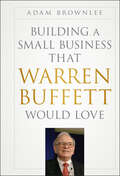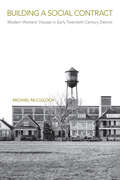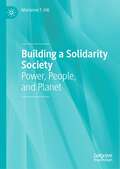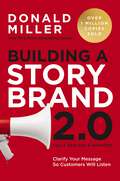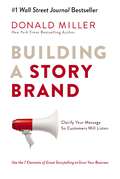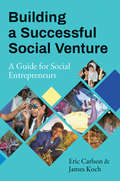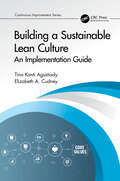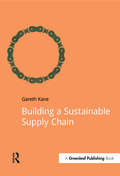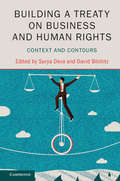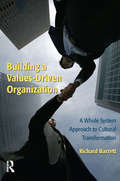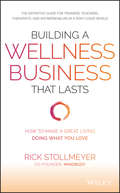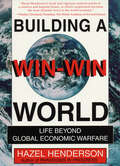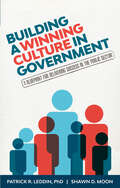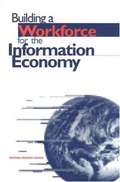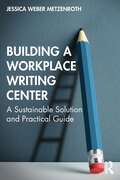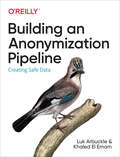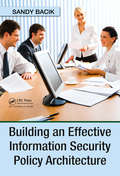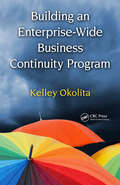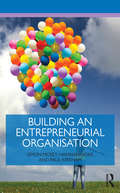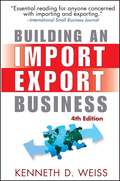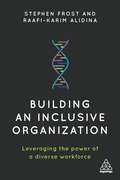- Table View
- List View
Building a Small Business that Warren Buffett Would Love
by Adam BrownleeThe guide to making money the Warren Buffett wayThe book that presents the same fundamentals that Warren Buffet used to turn an initial $105,000 investment into a $40 billion fortune in a way the general reader can apply, Building A Small Business that Warren Buffett Would Love is a succinct, logical, and straightforward guide to financial success. Highlighting one simple message: that Warren Buffett successfully invests in great businesses with strong fundamentals, it argues that these fundamentals can be replicated in a small business to yield outstanding results. Offering a solution for people wanting to start a business to provide additional income in today's uncertain economy, and designed to help entrepreneurs build fundamentally sound, small businesses using Warren Buffett's business investment perspective, the book covers:An overview of Warren Buffett's investment methodology and how it applies to small businessesThe details of the Buffett investment criteria--a consumer monopoly, strong earnings, low long term debt, and high ROE with the ability to reinvest earnings--and the application of these fundamentals to both start-up and existing small businessesAn approach to building a small business that applies the well respected principles of Warren Buffett, the book presents an exciting new look at the steps to success that have been proven trustworthy by one of the richest men in the world.
Building a Social Contract: Modern Workers' Houses in Early-Twentieth Century Detroit (Urban Life, Landscape and Policy)
by Michael McCullochThe dream of the modern worker’s house emerged in early twentieth-century America as wage earners gained access to new, larger, and better-equipped dwellings. Building a Social Contract is a cogent history of the houses those workers dreamed of and labored for. Michael McCulloch chronicles the efforts of employers, government agencies, and the building industry who, along with workers themselves, produced an unprecedented boom in housing construction that peaked in the mid-1920s. Through oral histories, letters, photographs, and period fiction, McCulloch traces wage earners’ agency in negotiating a new implicit social contract, one that rewarded hard work with upward mobility in modern houses. This promise reflected workers’ increased bargaining power but, at the same time, left them increasingly vulnerable to layoffs. Building a Social Contract focuses on Detroit, the quintessential city of the era, where migrant workers came and were Americanized, and real estate agents and the speculative housebuilding industry thrived. The Motor City epitomized the struggle of Black workers in this period, who sought better lives through industrial labor but struggled to translate their wages into housing security amid racist segregation and violence. When Depression-era unemployment created an eviction crisis, the social contract unraveled, and workers rose up—at the polls and in the streets—to create a labor movement that reshaped American capitalism for decades. Today, the lessons McCulloch provides from early twentieth-century Detroit are a necessary reminder that wages are not enough, and only working-class political power can secure affordable housing.
Building a Social Media Culture at Dell
by Michael Norris Rohit DeshpandeAs Michael Dell refocused his newly-private company on services and solutions, the entire corporation was pushed to embrace social media.
Building a Solidarity Society: Power, People, and Planet
by Marianne T. HillBUILDING A SOLIDARITY SOCIETY Is it the impossible dream: a caring and sustainable society that fosters the flourishing of people and planet? Many are deeply skeptical about whether such a transformative change is a goal worth pursuing. But pursuit of this goal may be our only realistic choice; the misuse of power then is the obstacle to be overcome. This book leads the skeptical reader — whether college student or underpaid worker — on an exploration of the priorities of the powerful, the economic theories that justify their decisions, and the alternative world views that are firing the imagination and efforts of activists across the globe.Economist Marianne Hill speaks to those who worry that switching from a capitalist to a democratic economy would kill the goose that lays the golden eggs. Drawing on cutting-edge scholarship, she explores why people accept a status quo in which the few have the right to control the labor of the many, and the right to distribute the wealth collectively created. Research findings, data and stories drawn from the COVID-19 pandemic and other recent crises are used to explain why plutocrats show little concern for the economic distress and insecurity suffered by so many.Steps can be taken to move us towards a more humane and sustainable way of living. Exciting possibilities are presented, based on recent manifestos, party platforms, books and documents. Advocates for a caring solidarity society are many and, once united, can be the force that redistributes power in firms, families and society. This book aims to foster the clarity, cohesion and courage that can ensure their success.
Building a StoryBrand 2.0: Clarify Your Message So Customers Will Listen
by Donald MillerWhen you apply the StoryBrand framework your brand will stand out. Developing that framework to clarify your message and grow your business is about to get a whole lot simpler. . .Since the original publication of Building a StoryBrand, over one million business leaders have discovered Donald Miller's powerful StoryBrand framework, and their businesses are growing. Now, the classic resource for connecting with customers has been fully revised and updated, making it an even more powerful tool to prepare you to engage customers.In a world filled with constant, on-demand distractions, it has become very hard for business owners to effectively cut through the noise to reach their customers. Without a clear, distinct message, customers will not understand what you can do for them and won't engage.In Building a StoryBrand 2.0, Donald Miller not only deepens his teaching on how to use his seven universal story elements—he'll provide you with one of the most powerful and cutting-edge tools to help with your brand messaging efficacy and output.The StoryBrand framework is a proven process that has helped thousands of companies engage with their existing customers, giving them the ultimate competitive advantage. Now you can have access to the perfected version, making it more essential.Whether you are the marketing director of a multibillion-dollar company, the owner of a small business, a politician running for office, or the lead singer of a rock band, Building a StoryBrand 2.0 will forever transform the way you talk about who you are, what you do, and the unique value you bring to your customers.
Building a StoryBrand: Clarify Your Message So Customers Will Listen
by Donald MillerNew York Times bestselling author Donald Miller uses the seven universal elements of powerful stories to teach readers how to dramatically improve how they connect with customers and grow their businesses.Donald Miller’s StoryBrand process is a proven solution to the struggle business leaders face when talking about their businesses. This revolutionary method for connecting with customers provides readers with the ultimate competitive advantage, revealing the secret for helping their customers understand the compelling benefits of using their products, ideas, or services. Building a StoryBrand does this by teaching readers the seven universal story points all humans respond to; the real reason customers make purchases; how to simplify a brand message so people understand it; and how to create the most effective messaging for websites, brochures, and social media. Whether you are the marketing director of a multibillion dollar company, the owner of a small business, a politician running for office, or the lead singer of a rock band, Building a StoryBrand will forever transform the way you talk about who you are, what you do, and the unique value you bring to your customers.
Building a Successful Social Venture: A Guide for Social Entrepreneurs
by Eric Carlson James KochThis is the first book on creating and running a social enterprise to combine theoretical discussions with current cases from around the world, filling a huge gap in the literature. It serves as an eminently practical blueprint for those who wish to build, sustain, and grow social ventures. Building a Successful Social Venture draws on Eric Carlson's and James Koch's pioneering work with the Global Social Benefit Institute, cofounded by Koch at Santa Clara University's Miller Center for Social Entrepreneurship. Since 2003, over 200 Silicon Valley executives have mentored more than 800 aspiring social entrepreneurs at the GSBI. It is this unparalleled real-world foundation that truly sets the book apart. Early versions of the book were used in both undergraduate and MBA classes.Part 1 of the book describes the assumptions that the GSBI model is based on: a bottom-up approach to social change, a focus on base-of-the-pyramid markets, and a specific approach to business planning developed by the GSBI. Part 2 presents the seven elements of the GSBI business planning process, and Part 3 lays out the keys to executing it. The book includes "Social Venture Snapshots" illustrating how different organizations have realized elements of the plan, as well as a wealth of checklists and exercises.Social ventures hold enormous promise to solve some of the world's most intractable problems. This book offers a tested framework for students, social entrepreneurs, and field researchers who wish to learn more about the application of business principles and theories of change for advancing social progress and creating a more just world.
Building a Sustainable Lean Culture: An Implementation Guide
by Elizabeth A. Cudney Tina AgustiadyThis book is an implementation guide for creating a Lean Culture from the ground up while gaining buy-in from key stakeholders and being able to sustain the results. Everyone talks about implementing a Lean Culture, but only provides Lean Tools for the implementation. This book discusses implementing the entire system from three main aspects. It will cover the people (structural and cultural), the operation system, and the tools. Also included is a full set of case studies to show real-life implementations as well. This text- Discusses Leader Standard work for all employees Covers the escalation process for tiers and daily accountability Shows how to deal with a change of SOP's and standardization within an organization Presents exercises for Lean Tools Implementation Offers real-life case studies of implementing a lean culture while sustaining it Building a Sustainable Lean Culture: An Implementation Guide discusses Lean Leadership from a managerial standpoint and ensures the lean journey does not fail through accountability, standardized work, and technological advances utilizing Lean Systems. Useful in manufacturing, services, IT, and healthcare, this book includes the implementation of empowering employees to want to build a Lean Culture.
Building a Sustainable Supply Chain (Doshorts Ser.)
by Gareth KaneThe massive oil spill in the Gulf of Mexico in 2010 was not caused by BP, but by a contractor, yet BP got the blame. The toxic waste from the production of Apple products dumped in China in 2011 was not dumped by Apple, but by a supplier, yet Apple got the blame. The horsemeat found in beef burgers in 2013 was not added by Tesco, but by a supplier, yet Tesco got the blame. In all three cases, blame for the damage caused by suppliers floated up through the supply chain until it lodged with the big brand at the top. No longer can companies constrain their corporate responsibility within the factory fence, as that boundary is not recognized by outside observers. This situation is exacerbated by the fact that the majority of most organizations’ environmental footprint lies in their supply chain. This means that, to address the sustainability agenda in a meaningful way, they must tackle the impacts of their suppliers. Unfortunately this is a huge challenge as visibility and influence diminishes quickly as you start to work your way down through the layers of suppliers. This book gives a quick but comprehensive guide to the most effective techniques to help you proactively address environmental risks in the supply chain. It covers the following: the business case for a sustainable supply chain; supply chains and sustainability: the big picture; making supply chains sustainable: the fundamentals; basic techniques: the "hard yards" of green procurement; intermediate techniques: those requiring changes to operations and products/services; advanced techniques: changes to the business model and corporate philosophy.The book draws upon exclusive interviews with top sustainability practitioners along with the practical experiences of the author to provide real world examples at the cutting edge.
Building a Systemic Innovation Capability
by Rowan Gibson Peter SkarzynskiThis chapter outlines a framework for developing, deploying, and sustaining a systemic innovation capability in the context of your own business.
Building a Treaty on Business and Human Rights: Context and Contours
by Surya Deva David BilchitzThe calls for an international treaty to elaborate the human rights obligations of transnational corporations and other business enterprises have been rapidly growing, due to the failures of existing regulatory initiatives in holding powerful business actors accountable for human rights abuses. In response, Building a Treaty on Business and Human Rights explores the context and content of such a treaty. Bringing together leading academics from around the world, this book engages with several key areas: the need for the treaty and its scope; the nature and extent of corporate obligations; the role of state obligations; and how to strengthen remedies for victims of human rights violations by business. It also includes draft provisions for a proposed treaty to advance the debate in this contentious area and inform future treaty negotiations. This book will appeal to those interested in the fields of corporate social responsibility and business and human rights.
Building a Values-Driven Organization
by Richard BarrettRichard Barrett, author of the best-selling book Liberating the Corporate Soul, presents his new thinkingBased on his experience working with over 1,000 organizations in 32 countries on cultural transformation for the values-driven organization. He presents a whole system approach to cultural transformation, showing organizations how they can change their culture to become values-driven organizations that support their employees, their customers, their partners, their leaders, and ultimately drive effectiveness and profit.
Building a Wellness Business That Lasts: How to Make a Great Living Doing What You Love
by Rick StollmeyerStart and grow a durable business in the rapidly growing wellness industry! Wellness has become one of the largest and most important business opportunities of our age, fueled by massive societal trends, rapid technology innovations and hundreds of thousands of wellness business entrepreneurs. It is these independent teachers, trainers, and therapists, and studio, gym, spa and salon owners who transforming shopping malls and downtown districts with wellness experiences that help hundreds of millions of people live healthier, happier lives. Whether your goal is to open a neighborhood wellness business, work independently from home, or launch the next highly successful wellness brand Building a Wellness Business That Lasts: How to Make a Great Living Doing What You Love is your definitive guide. This book will teach you how to translate your passion for wellness into a compelling business vision, weave that vision into an effective business plan, and leverage the latest technologies to accelerate your growth. Author Rick Stollmeyer is the Co-Founder and CEO of Mindbody, Inc., the leading technology platform for the wellness industry. Across more than two decades, Rick built Mindbody from a garage startup into a multi-billion-dollar technology platform for the wellness industry, helping thousands of wellness business owners achieve their visions in the process. This experience gave Rick a front-row seat to the explosive growth of the wellness industry. He brings that unique experience and his passion for entrepreneurialism to Building a Wellness Business That Lasts. This book will inspire and inform you at the same time and will serve as a powerful guide you can refer back to on your path to success.
Building a Win-Win World: Life Beyond Global Economic Warfare
by Hazel HendersonIn Building a Win-Win World , world-renowned futurist Hazel Henderson extends her twenty-five years of work in economics to examine the havoc the current economic system is creating at the global level. Markets are now spreading worldwide-a spread which is often equated with the hope of democracy spreading along with it. But markets still run on old textbook models that ignore social and environmental costs-leading to a new kind of warfare: global economic warfare. Building a Win-Win World demonstrates how the global economy is unsustainable because of its negative effects on employees, families, communities, and the ecosystem. Henderson shows that win-win strategies can become the norm at every level when people see the true current and future costs of short-sighted, narrow economic policies. Henderson shows how humans are encountering the endgames of the competition/conflict paradigm, and identifies the signs of transition. Using warfare as a metaphor for the dark side of today's world economic system, she shows how both are destructive, inhumane, wasteful, irrational, inefficient, competitive, and crisis-driven. Both create more new problems than they solve. She describes how the globalization of the war system, technology, and industrialization brought the Cold War to a dead end. By the mid-1980s the global warfare paradigm had given ground to a global economic warfare which many economists, politicians, and business leaders hailed as a victory of capitalism and competitive "free markets." Yet this new type of warfare proved little better than the military warfare it was advertised to replace. By the mid-1990s global economic warfare had already reached crisis points of its own. Building a Win-Win World examines how jobs, education, health care, human rights, democratic participation, socially responsible business, and environmental protection are all sacrificed to "global competitiveness." Henderson shows many ways out of the dilemmas faced by all countries. New agreements are described to tame the global economic casino, regulate multi-national corporations, and levy fees for commercial use of global common resources-oceans, atmosphere, space, etc.-and tax their abuse. These revenues can then be invested in civilian needs and sectors worldwide. She also describes a trend toward "grassroots globalism"-citizens movements that are addressing poverty, social inequities, pollution, resource-depletion, violence, and wars. Grassroots globalism, she says, is about thinking and acting-globally and locally. It is pragmatic problem-solving, implementing local solutions that keep the planet in mind. Such social innovations can raise the ethical floor under the global playing field so that the most ethical companies and countries can win.
Building a Winning Culture In Government: A Blueprint for Delivering Success in the Public Sector
by Patrick R. Leddin Shawn D. Moon Patrick LeddinThe strategic consultant and author of Talent Unleashed presents a revolutionary blueprint for organizational success in government.Today’s government organizations face political fallout, media scrutiny, reduced funding, and the challenges of motivating large, highly regulated organizations. In many offices, these challenges have led to a vicious cycle of employee disengagement. As performance declines, scrutiny increases, and employee paralysis sets in. Breaking this cycle requires a new approach.As an Executive Vice President at Franklin Covey, Patrick Leddin helped organizations all over the world transform their culture and unleash their potential with five highly effective practices. In Building a Winning Culture in Government, he shows how government organizations can implement these same practices to inspire their employees, revitalize engagement, and become more responsive to the public interest.In Building a Winning Culture in Government, you will learn to:Lead with purpose and find your organization's mission, mantra, or manifesto.Make the 7 Habits of Highly Successful People your organization's operating system.Inspire people to go beyond your expectations.Build trust withing the organization and with the public.Create loyalty with all stakeholders.
Building a Workforce for the Information Economy
by National Research CouncilA look at any newspaper's employment section suggests that competition for qualified workers in information technology (IT) is intense. Yet even experts disagree on not only the actual supply versus demand for IT workers but also on whether the nation should take any action on this economically important issue.Building a Workforce for the Information Age offers an in-depth look at IT. workers-where they work and what they do-and the policy issues they inspire. It also illuminates numerous areas that have been questioned in political debates: Where do people in IT jobs come from, and what kind of education and training matter most for them? Are employers' and workers' experiences similar or different in various parts of the country? How do citizens of other countries factor into the U.S. IT workforce? What do we know about IT career paths, and what does that imply for IT workers as they age? And can we measure what matters? The committee identifies characteristics that differentiate IT work from other categories of high-tech work, including an informative contrast with biotechnology. The book also looks at the capacity of the U.S. educational system and of employer training programs to produce qualified workers.
Building a Workplace Writing Center: A Sustainable Solution and Practical Guide
by Jessica Weber MetzenrothThis practical resource provides guidance for writing professionals to sustainably tackle the organizational writing challenges of any professional environment. Rooted in applied experience, Building a Workplace Writing Center guides readers through the process of developing a writing center, from assessing the needs of an organization and pitching the idea of a writing center, to developing a service model and measuring progress. Chapters explore what a writing center can offer, such as one-on-one writing consultations, tailored group workshops, and standardized writing guidance and resources. Although establishing a writing center requires time and a shift in culture up front, it is a rewarding process that produces measurably improved writing, less frustration with the writing and revision processes, and more confident, independent writers. This guide is an invaluable resource for professionals across industries and academia considering how to establish an embedded, sustainable, and cost-effective workplace writing center. It will be of particular interest to business and human resource managers considering how best to improve writing skills within their organizations.
Building an Analytical Culture: A Key Element of Embedding Analytics in Your Organization
by Thomas H. Davenport Jeanne G. Harris Robert MorisonCulture is one of the softer elements of an organization's makeup, one that may seem incompatible with the "hard" nature of analytics. But building a culture that embraces analytics is critical if you want your firm, and all the people in it, to make better decisions based on data, facts, and rigorous analysis. Getting to this point isn't quick or easy, but once you're there it becomes a competitive advantage. In this chapter, the authors of the definitive book Competing on Analytics explain what traits and behaviors your organization should champion to foster an analytical approach and reward data-driven insights. Through real-life success stories culled from years of research, you will learn the common attributes that an analytical culture embraces, firm but fair "pushbacks" you can incorporate to combat the wrong behaviors, and how to produce a mutually beneficial set of priorities that correspond to both your existing cultural themes and a new analytic focus. This chapter was originally published as Chapter 8 of Analytics at Work: Smarter Decisions, Better Results.
Building an Anonymization Pipeline: Creating Safe Data
by Luk Arbuckle Khaled El EmamHow can you use data in a way that protects individual privacy but still provides useful and meaningful analytics? With this practical book, data architects and engineers will learn how to establish and integrate secure, repeatable anonymization processes into their data flows and analytics in a sustainable manner.Luk Arbuckle and Khaled El Emam from Privacy Analytics explore end-to-end solutions for anonymizing device and IoT data, based on collection models and use cases that address real business needs. These examples come from some of the most demanding data environments, such as healthcare, using approaches that have withstood the test of time.Create anonymization solutions diverse enough to cover a spectrum of use casesMatch your solutions to the data you use, the people you share it with, and your analysis goalsBuild anonymization pipelines around various data collection models to cover different business needsGenerate an anonymized version of original data or use an analytics platform to generate anonymized outputsExamine the ethical issues around the use of anonymized data
Building an Effective Information Security Policy Architecture
by Sandy BacikInformation security teams are charged with developing and maintaining a set of documents that will protect the assets of an enterprise from constant threats and risks. In order for these safeguards and controls to be effective, they must suit the particular business needs of the enterprise.A guide for security professionals, Building an Eff
Building an Effective Team: How New Managers Can Rise to the Challenge of Team Management
by Linda A. HillDue to advances in technology and the move toward globalization, new managers must step into roles involving increasing complexity and interdependence. The capacity to employ collaborative effort--coordination across individuals, activities, or functions so that performance of the whole is greater than the sum of the parts--is one of the toughest managerial skills to acquire. New managers generally recognize their responsibility to build effective teams, but do not fully appreciate what it will take to do so. How to rise to the challenge? In this chapter, expert Linda A. Hill provides new managers with the building blocks of effective team management. This chapter was originally published as Chapter 11 of "Becoming a Manager: How New Managers Master the Challenges of Leadership."
Building an Enterprise-Wide Business Continuity Program
by Kelley OkolitaIf you had to evacuate from your building right now and were told you couldn't get back in for two weeks, would you know what to do to ensure your business continues to operate? Would your staff? Would every person who works for your organization? Increasing threats to business operations, both natural and man-made, mean a disaster could occur at any time. It is essential that corporations and institutions develop plans to ensure the preservation of business operations and the technology that supports them should risks become reality. Building an Enterprise-Wide Business Continuity Program goes beyond theory to provide planners with actual tools needed to build a continuity program in any enterprise. Drawing on over two decades of experience creating continuity plans and exercising them in real recoveries, including 9/11 and Hurricane Katrina, Master Business Continuity Planner, Kelley Okolita, provides guidance on each step of the process. She details how to validate the plan and supplies time-tested tips for keeping the plan action-ready over the course of time. Disasters can happen anywhere, anytime, and for any number of reasons. However, by proactively planning for such events, smart leaders can prepare their organizations to minimize tragic consequences and readily restore order with confidence in the face of such adversity.
Building an Entrepreneurial Organisation
by Hannah Noke Paul Kirkham Simon MoseyEntrepreneurship is often focused on understanding new ventures, but the entrepreneurial flame is required in growing organisations too. This textbook examines how organisations can become more entrepreneurial to achieve sustainable growth. The authors show how entrepreneurship can be used to address crisis points of growth within small firms and to overcome the limitations of stagnation within large firms. By integrating entrepreneurship and innovation management, the book presents a framework to diagnose entrepreneurial behaviour within existing firms. Drawing upon research and reflecting practice across a range of industries, from football, through Silicon Valley, to the retail sector, it includes insights from leading practitioners. The authors build an understanding of entrepreneurship in context to provide diagnostic tools to help organisations make entrepreneurship central to their culture. This unique text is therefore useful reading for business students from advanced undergraduate to executive education.
Building an Import / Export Business
by Weiss Kenneth D.This bestselling, up-to-date guide shows you how to start your own import/export business, from researching a raw idea to a successful launch to ongoing, profitable business operations. Complete with real-life examples from importers and exporters, it helps you every step of the way, from targeting a market and preparing a business plan to dealing with foreign currencies, shipping procedures, customs requirements, and more. It also shares tips to help you take advantage of NAFTA and other trade pacts, plus online resources to help you start and grow your business.
Building an Inclusive Organization: Leveraging the Power of a Diverse Workforce
by Stephen Frost Raafi-Karim AlidinaA diverse workforce is a business imperative. Without it, companies are made up of employees who come from the same background and have the same skills and, therefore, the same blind spots. A diverse workforce brings together different strengths, a variety of experiences, a huge breadth of knowledge and a wealth ofcreative problem-solving techniques. However, in order to leverage the benefits of this diverse workforce, businesses must be inclusive. Inclusion ensures that employees feel supported, are treated fairly and are therefore happier, more engaged and more productive. Building an Inclusive Organization is a practical guide to creating an environment of real inclusion. It explains how to remove unconscious bias from company processes including recruitment and selection, how to make the case for diversity and inclusion to all stakeholders and how to embed inclusion into an organization's culture and overall business strategy.Packed with case studies from organizations including KPMG, Uber, Salesforce, Harvard University and the UK National Health Service (NHS), Building an Inclusive Organization shows how to implement robust processes and policies to foster diversity and inclusion in organizations of any size, and in all sectors, including the creative industry, finance, tech, and academia and foundations. Guidance and advice is also provided on how to use 'nudges' to change behaviours and overcome bias, how to achieve transparency and accountability, and how to measure, review and evaluate inclusion.
